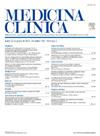Prevalencia de enfermedad vascular subclínica en función del riesgo vascular estimado y la presencia de síndrome metabólico
IF 2.1
4区 医学
Q1 MEDICINE, GENERAL & INTERNAL
引用次数: 0
Abstract
Most vascular complications occur in persons with a low or moderate calculated vascular risk. We have evaluated the added prediction of the metabolic syndrome (MS) to the presence of subclinical vascular disease (SVD), beyond that estimated by the cardiovascular risk calculation.
Patients and methods
Cross-sectional population-based study, in 1,061 subjects aged 45 to 75 years, without diabetes or known vascular disease, randomly selected from the Primary Care registries of Madrid (Spain). Vascular risk was calculated using SCORE2 and SCORE2-OP, the presence of MS was determined, and the prevalence of SVD was established by quantification of carotid plaques and ankle-brachial index.
Results
Of the included population, 40.2% was at low/moderate risk, 54.5% at high risk and 5.3% at very high risk. A total of 36.1% met the criteria for MS. The prevalence of SVD was 27.7, 50.1 and 71.4% in subjects at low/moderate, high and very high risk without MS, and 42.5, 62.6 and 78.6% if they had MS, respectively. The association of MS with the presence of EVS was independent of its separate components. A total of 23.1% of the participants were receiving statin treatment. Statin use was independent of the calculated cardiovascular risk and much higher in subjects with MS (38.6 vs. 12.8%).
Conclusion
Subjects with MS have a high prevalence of SVD, independent of the estimated risk. The use of statins is more prevalent in subjects with the MS, and is independent of the estimated cardiovascular risk.
亚临床血管疾病的患病率与估计的血管风险和代谢综合征的存在有关
大多数血管并发症发生在计算血管风险为低或中等的人群中。我们已经评估了代谢综合征(MS)对亚临床血管疾病(SVD)存在的附加预测,超出了心血管风险计算的估计。患者和方法基于人群的横断面研究,从马德里(西班牙)的初级保健登记处随机选择1061名年龄在45至75岁之间,无糖尿病或已知血管疾病的受试者。使用SCORE2和SCORE2- op计算血管风险,确定MS的存在,通过量化颈动脉斑块和踝肱指数来确定SVD的患病率。结果低/中危人群占40.2%,高危人群占54.5%,极高危人群占5.3%。低/中、高、极高风险无MS组SVD患病率分别为27.7%、50.1%和71.4%,有MS组SVD患病率分别为42.5%、62.6%和78.6%。MS与EVS存在的关联是独立于其单独成分的。共有23.1%的参与者接受了他汀类药物治疗。他汀类药物的使用与计算的心血管风险无关,并且在MS患者中更高(38.6% vs 12.8%)。结论多发性硬化症患者SVD患病率高,与估计风险无关。他汀类药物的使用在多发性硬化症患者中更为普遍,并且与估计的心血管风险无关。
本文章由计算机程序翻译,如有差异,请以英文原文为准。
求助全文
约1分钟内获得全文
求助全文
来源期刊

Medicina Clinica
医学-医学:内科
CiteScore
3.10
自引率
5.10%
发文量
295
审稿时长
22 days
期刊介绍:
Medicina Clínica, fundada en 1943, es una publicación quincenal dedicada a la promoción de la investigación y de la práctica clínica entre los especialistas de la medicina interna, así como otras especialidades. Son características fundamentales de esta publicación el rigor científico y metodológico de sus artículos, la actualidad de los temas y, sobre todo, su sentido práctico, buscando siempre que la información sea de la mayor utilidad en la práctica clínica.
 求助内容:
求助内容: 应助结果提醒方式:
应助结果提醒方式:


